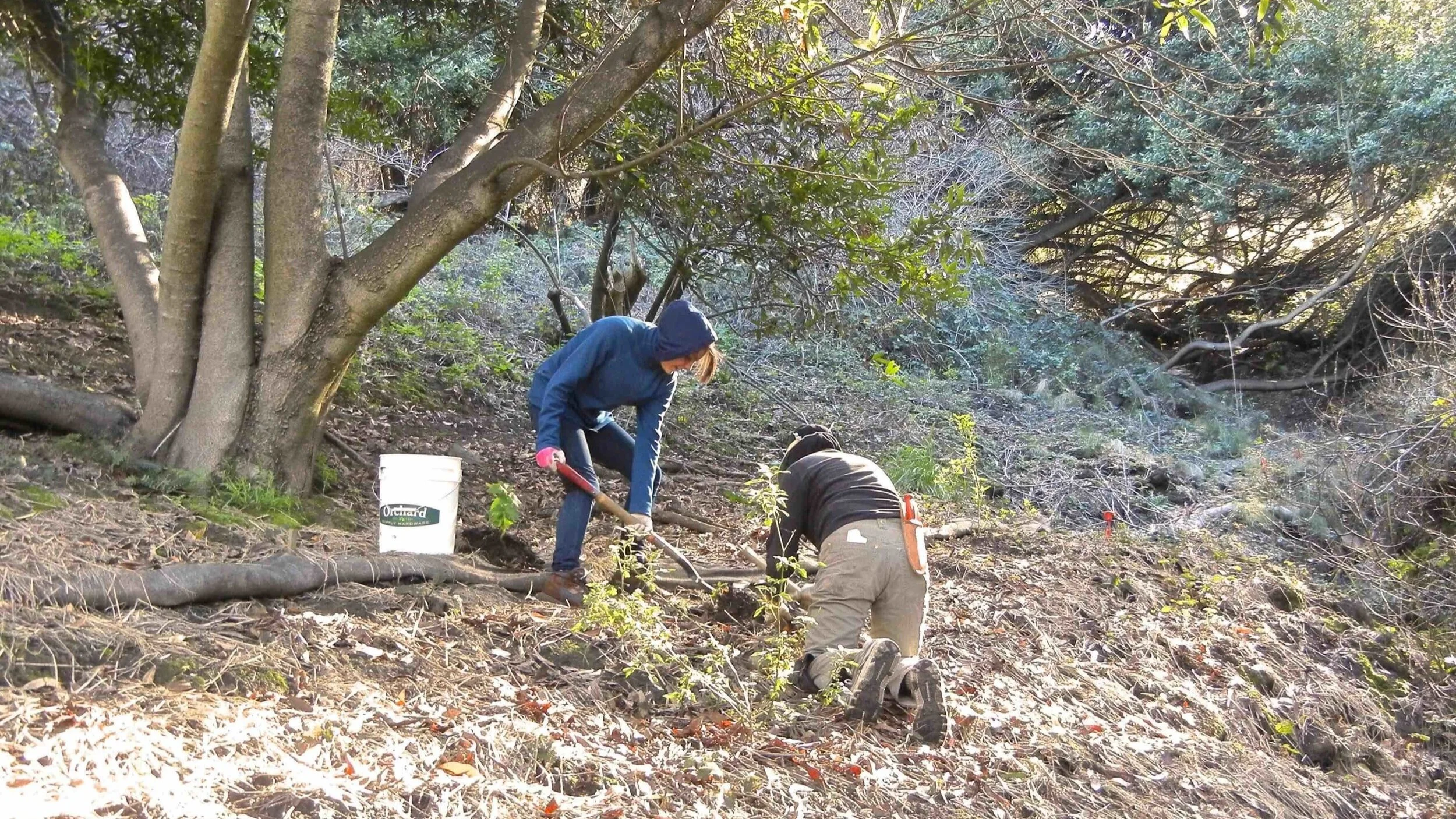The Conservancy’s eleventh annual meeting was held at the Claremont Hotel, November 4 with our keynote speaker, Jon Keeley, PhD.
Invasive tree removal expected to go forward, by Jon Kaufman
THE UNIVERSITY OF CALIFORNIA’S PROGRAM of invasive tree removal from its land in upper Claremont Canyon has been on hold for the past three years while a federal environmental study assesses the environmental impacts of fire mitigation projects planned for the East Bay hills. Over 9,000 trees, mostly hazardous eucalyptus, have already been removed through UC’s program in Claremont Canyon. If all goes well, the program is expected to resume in 2013 or 2014.
President's message, by L. Tim Wallace
IT IS MY PLEASURE TO ANNOUNCE that Jon Keeley has agreed to be the featured speaker at our annual meeting on Sunday, November 4. Dr. Keeley last spoke to the Conservancy in the autumn of 2007—five years ago—so we’re pleased to have him back again to discuss the most important new findings in the field of wildfire behavior, climate, and local conditions.
Stewardship in the Stonewall area, by Marilyn Goldhaber
Barry Pilger saved the day by showing up with a gas powered hedge trimmer to rid the slope of several large stands of pampas grass. (We went back later that day with some old tarps and covered the pampas grass stumps to inhibit resprouting.) Ray Johnston also showed up and helped us rid the area of spurge (euphorbia) while the rest of us toured the rugged and steep area behind some homes as a site for future fuel break/wildfire mitigation work.
A busy spring for Garber Park, by Shelagh Brodersen
Illegal dumping deterred, by Joe Engbeck
In past years, Claremont Canyon was often used as a dumping ground for small-time, fly-by-night construction contractors and others who were not willing to pay the fees charged by official dumps. Debris of all kinds—car parts, plywood, plasterboard, empty paint cans, and even a few refrigerators and sofas—ended up on the roadside or down in the creek bed below the road.
The upper canyon thrives, by Jon Kaufman
Winter bird walk with Dave Quady, by Kay Loughman
Restoring a north coastal grassland, by Marilyn Goldhaber
A tenth anniversary, by L. Tim Wallace
Spring Bird Walk: this morning in Claremont Canyon, by Dave Quady
Birds and birding in Claremont Canyon, by Kay Loughman
From the president's desk, by L. Tim Wallace
THIS WILL BE THE CONSERVANCY’S TENTH YEAR anniversary, and we want to celebrate it with you—not only on November 6th at our Annual Meeting (mark your calendars), but throughout the year. At each of our nature walks, at each of our stewardship days where ever they may be in Claremont Canyon, at each of our special events, we all hope you join us and become part of the discussion about the local treasure that is Claremont Canyon.
Honoring our members, by Marilyn Goldhaber
HONORING OUR MEMBERS: From our founding in 2001, we have encouraged nearby residents and community organizations to support the Conservancy by becoming Founding Sponsors with a commitment to contribute $1,000, either all at once or over ten years. We are pleased to list in our Spring 2011 newsletter, in approximately the order the commitments were made, our first 209 Founding Sponsors.
Winter birding field trip, by Kay Loughman
A botanical exploration with Lech Naumovich, by Marilyn Goldhaber
Native plants at the Pacifica site with Jake Sigg, by Marilyn Goldhaber
A DOZEN CONSERVANCY MEMBERS AND FRIENDS visited the Pacifica Foundation site of the KPFA Radio Towers overlooking Gwin and Claremont Canyons, with Jake Sigg, long-time advocate of native plant restoration in the Bay Area and author of the widely read “Nature News from Jake Sigg.” Jake helped us identify native plants and provided insights on the landscape, a naturally rough and exposed knoll overlooking much of the bay area to the west and Mount Diablo and the inner valley to the east.
President's message, by Barry Pilger
AS SUMMER TURNS TO FALL Claremont Canyon can take on a special beauty after our recent relatively wet spring and mild summer. A drive up Claremont Avenue, or better yet a walk onto a canyon trail, whether through Garber Park, from Four Corners to the chert, or a more ambitious hike from the Stonewall trailhead to Grizzly Peak Boulevard and back, is just what one needs to be reminded of the natural beauty that is right in our backyard.
Wildfire hazard reduction and resource management plan-an update, by Pat O'Brien
ON APRIL 20, 2010 THE PARK DISTRICT Board of Directors unanimously approved the Park District’s Wildfire Hazard Reduction and Resource Management Plan and its accompanying EIR. The approval followed six years of hard work by staff, consultants, natural resource specialists, planners, cooperating agencies, and the public, and will pave the way for important fire hazard reduction work to begin in Claremont Canyon and several other East Bay Hills regional parks.
Making Claremont Canyon fire-safe, working with UC
Over the last nine years, the Conservancy has developed a strong working relationship with the University of California and its restoration and fire safety projects in Claremont Canyon. Much of our shared concern has focused on the dense groves of eucalyptus on U.C. land in the upper portion of the Canyon.

